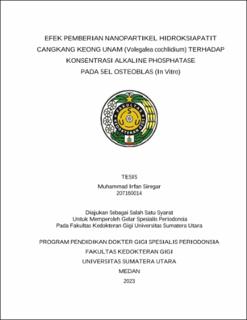Efek Pemberian Nanopartikel Hidroksiapatit Cangkang Keong Unam (Volegalea cochlidium) terhadap Konsentrasi Alkaline Phosphatase pada Sel Osteoblas (In Vitro)
Effect of Giving Unam Snail Shell (Volegalea cochlidium) Hydroxyapatite Nanoparticles on Alkaline Phosphatase Concentration in Osteoblast Cells (In Vitro)

Date
2023Author
Siregar, Muhammad Irfan
Advisor(s)
Nasution, Aini Hariyani
Agusnar, Harry
Metadata
Show full item recordAbstract
Background: Periodontal disease is a group or condition that can cause inflammation and damage to dental tissue, namely gingiva, periodontal ligament, cementum and alveolar bone. One of the complications caused by periodontitis is bone loss, the treatment is bone grafting with bone graft material. Hydroxyapatite is a bioactive ceramic that has been widely used in bone repair and is the main mineral contained in mammalian bones and teeth. One source of HA powder is natural biological sources such as unam snail shells (Volegalea cochlidium).
Objective: To analyze the effect of hydroxyapatite nanoparticle from Unam Snail (Volegalea cochlidium) shell on the concentration of alkaline phosphatase in osteoblast cells in vitro.
Method: The fabrication of hydroxyapatite nanoparticles from Unam snail shells using a combination of mechanical-chemical methods known as ball mill and sol gel. Osteoblast cells were obtained from rat calvaria which were cultured in DMEM media. Osteoblast cell differentiation was proven by measuring the alkaline phosphatase concentration and then reading it with an Elisa reader.
Results: The highest average ALP concentration value was obtained at a concentration of 1.25 mg/mL on day 7, namely 70.38 ± 7.14 μL, then followed sequentially from high to low concentration, namely 1.5 mg/mL, 1, 75 mg/mL, 2 mg/mL and control on the same day, namely 59.27 ± 6.39 μL, 52.29 ± 0.48 μL, 46.41 ± 3.10 μL and 44.51 ± 6.21 μL.
Conclusion: The highest ALP concentration on days 1, 3 and 7 of all observation groups was obtained in the treatment group given Unam Snail (Volegalea cochlidium) shell hydroxyapatite nanoparticles at a concentration of 1.25 mg/mL. This shows that administration of this material can increase the activity of differentiated osteoblast cells.
Collections
- Master Theses [39]
